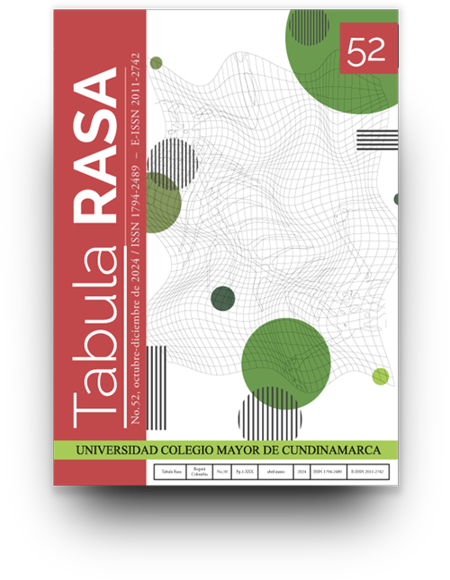The Grotesque Representation of the Spanish Nation in Goya’s Los Caprichos
La representación grotesca de la nación española en los Caprichos de Goya
Show authors biography
The life of Francisco de Goya, a masterful artist whose life spanned the period between the Enlightenment and the turbulent changes in Spain during the 18th and 19th centuries. From 1792 onwards, his works took on a more introspective tone, particularly evident in his series Los Caprichos [The Caprices]. This essay delves into three prints: Todos caerán [All will fall], ¿Dónde va mamá? [Where is Mother going?] and Hilan delgado [They spin finely], where Goya portrays women with grotesque features. It argues that Goya’s art was a profound critique of the Spanish nation, which he saw as transforming into a bestial and oppressive stepmother. This essay brings to light the prevalent ignorance and ferocity of that era, embodied by monstrous maternal figures. By drawing upon the theories of national identity by Benedict Anderson, Jackie Hogan, and Tamar Mayer, the article unravels the complex relationship between nationality and the monstrous maternal figure in Goya’s art.
Article visits 0 | PDF visits 0
Downloads
- Alcalá Flecha, R. (1984). Matrimonio y prostitución en el arte de Goya. Universidad de Extremadura.
- Álvarez Junco, J. (2010). Mater Dolorosa. La idea de España en el siglo XIX. Taurus.
- Anderson, B. (1991). Imagined Communities. Reflections on the Origin and Spread of Nationalism. Verso.
- Blas Benito, J. (2000) La cuadratura del círculo. Goya ante la mirada ajena. Goya, personajes y rostros. Barcelona: Fundació Caixa Catalunya.
- Calvo Serraller, F. (2001). Goya: la imagen de la mujer. Museo Nacional del Prado Carr-Gomm, Sarah. (2005). Francisco Goya, Parkstone International.
- Charro Gorgojo, M. Á. (1997). Lechuzas y búhos, ¿aves de mal agüero? Revista de Folklore, 195(17), 75-82.
- Crivellato, V. (1962). Tiépolo. Istituto italiano d´arti grafiche.
- Cruz, J. (1996). De cortejadas a ángeles del hogar. Algunas reflexiones sobre la posición de la mujer en la elite madrileña, 1750-1850. En A. Saint-Saënz (ed.). Historia silenciada de la mujer. La mujer española desde la época medieval hasta la contemporánea (pp. 135- 160). Editorial Complutense.
- De Miguel, A. A. (1989). Iconografía femenina en los Caprichos de Goya. Cuadernos de arte e iconografía, 2(4), 227-233.
- Dijkstra, B. (1986). Idols of perversity. Oxford University Press.
- Fernández Poncela, A. (2002). Estereotipos y roles de género en el refranero popular. Anthropos.
- Forner, J. P. (1794). Amor de la Patria. Hijos de Hidalgo y González de la Bonilla. https:// www.cervantesvirtual.com/obra-visor/amor-de-la-patria--0/html/ff16be8e-82b1-11df acc7-002185ce6064_2.html
- Gómez Castellano, I. (2009). La mujer frente al espejo: escenas de tocador vistas por Goya y Meléndez Valdés. Hispanófila, 157, 79-97.
- Halasz, C. (2008). La parodia como motivo básico del Esperpento en «Luces de Bohemia» de Valle-Inclán. Grin Verlag.
- Hogan, Jackie. (2009). Gender, Race and National Identity. Routledge.
- Hydak, L. (2016). Sobre máscaras y malvadas: la imagen de la mujer en los Caprichos de Goya. Gacéta Hispánica de Madrid, 10, 1-27.
- Lipschutz, I. H. (1976) Theophile Gautier. Su España legendaria y los Caprichos de Goya. Revista de Occidente, 14, 16-27.
- Mayer, T. (2000). Gender Ironies of Nationalism. Sexing the Nation. Routledge. Mitchell, W. J. T. (1986). Iconology. Image, Text, Ideology. The University of Chicago Press. Noddings, N. (1989). Women and Evil. University of California Press.
- Pedraza, P. (2001). La vieja desnuda. Brujería y abyección. En A. Cancellier & R. Londero (coord.). Atti del XIX Convegno, Roma, 16-18 settembre 1999: Le arti figurative nelle letterature iberiche e iberoamericane (pp. 5-18). Associazione ispanisti italiani / Unipress.
- Reyero, C. (2010). Alegoría, nación e identidad. Siglo XXI.
- Ruddick, S. (1995). Maternal Thinking. Beacon Press.
- Schulz, A. (2005). Goyas caprichos. Cambridge University Press.




